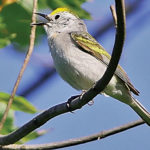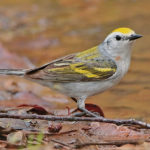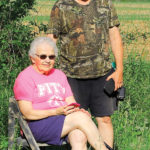Blair native discovers new hybrid bird
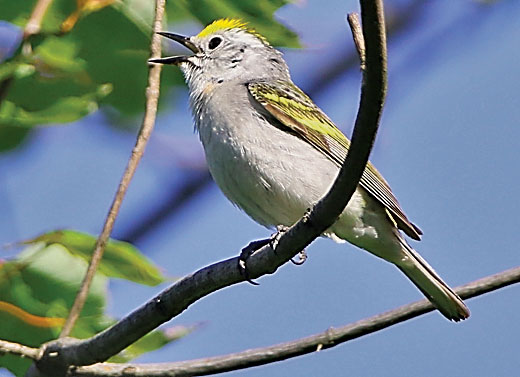
A newly discovered hybrid bird — Burket’s warbler — sings at an area park. Courtesy photo
- A newly discovered hybrid bird — Burket’s warbler — sings at an area park. Courtesy photo
- Burket’s warbler was photographed May 7. Courtesy photo
- Brian Burket stands with his mother, Gwen Burket, on their Roaring Spring farm on Monday. Courtesy photo
Cornell Lab of Ornithology & Department of Ecology and Evolutionary Biology named the rare, three-species hybrid Burket’s Warbler for the 1975 graduate of Northern Bedford County High School.
Burket co-authored a research article on the bird that was published Nov. 7 in the peer-review science journal “Biology Letters,” published by the Royal Publishing Society in London, England. The lead author is Dave Toews, a Cornell researcher, who, with Burket’s assistance, netted, tested and tagged the male bird this summer.
Blood samples confirmed its unique lineage. It is the offspring of a hybrid, Brewster’s warbler mother and a Chestnut-sided warbler.
“This bird is the result of something scientists said couldn’t be done,” Burket said. Since the article appeared, Burket’s photos and video have gone viral internationally — as of Nov. 20, it has appeared on the web in 205 publications in 34 countries.
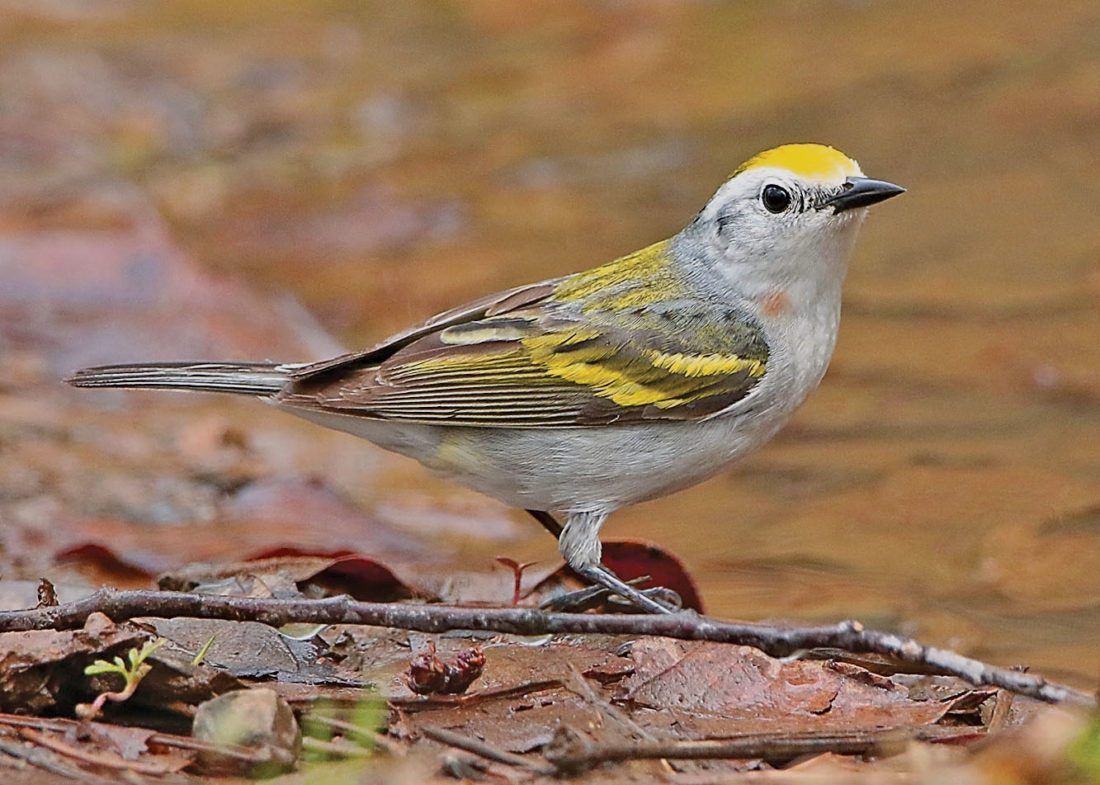
Burket’s warbler was photographed May 7. Courtesy photo
“Roaring Spring is mentioned in every article, and my phone is blowing up constantly,” he said. He’s been interviewed by journalists from as far away as Romania, Israel and Norway. “A friend texted me that he saw my video on MSN. When I saw it, the tears just rolled down my face.”
Married to the former Annette Stump of Hollidaysburg, Burket credits his father-in-law, Larry Stump, with introducing him to bird watching eight years ago and guiding him through the process of contacting experts at Cornell.
Toews, the Cornell expert, uses this analogy to explain why the disovery is creating news.
“It would also be analogous to a chimp mating with a bonobo (different species, but same genera), with the hybrid of that offspring going on to mate and successfully reproduce with a gorilla (same family, but different genera). Obviously, there are lots of reasons why that would never happen, but it gives you some perspective of the levels of differences we are talking about,” he stated.
“It is extremely rare for anyone, let alone a fairly new birder, to discover a new hybrid,” said Laura Jackson, vice president and former president of the Juniata Valley Audubon Society. “Many hybrids are sterile and a ‘dead end’ in evolutionary terms, but they bring a lot of excitement because they are so rare. The concept of species is a manmade constraint, so sometimes what are considered different species are able to mate and produce offspring due to similar physical and genetic traits,” Jackson said.
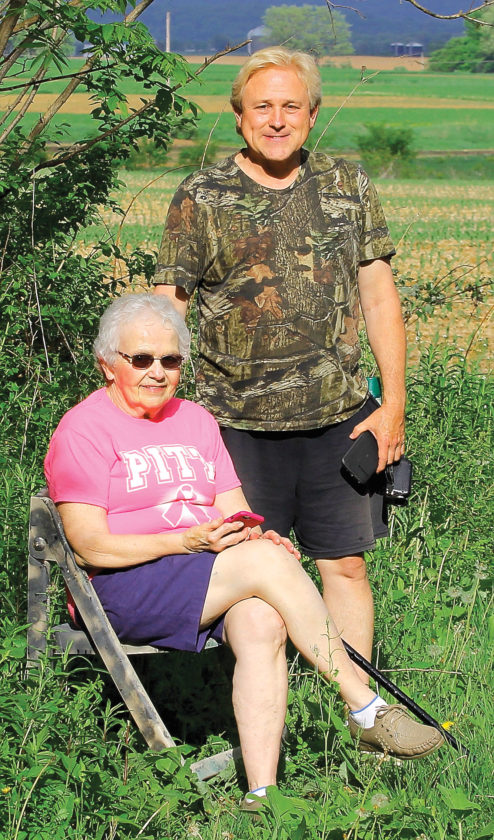
Brian Burket stands with his mother, Gwen Burket, on their Roaring Spring farm on Monday. Courtesy photo
According to a story by HuffPost, Burket noticed that the bird had the physical attributes of the blue-winged warbler and golden-winged warbler, but sang like a third species, the chestnut-sided warbler. The bird piqued his interest enough that, after taking photos and video, he contacted the Fuller Evolutionary Biology Lab at Cornell.
“I tried to make the email sound somewhat intellectual so they wouldn’t think I was a crackpot,” he said.
Luckily, the lab did not think Burket was a crackpot, and researcher Toews soon got in touch with him. The results of lab’s analysis were published several weeks ago in the science journal Biology Letters.
“I am enjoying (the attention),” Burket said. “However, I don’t think it has truly hit me yet. I haven’t sat and thought about how it’s named for me. It’s in the book, and 100 years from now, someone will be looking for Burket’s warbler. This is the ultimate dream for a birder.”
The majority of feedback he’s received from fellow birders has been positive, although one online comment expressed concern for the bird.
“I’d like to clarify that the bird was not harmed during the tagging process by Dr. Toews. It was like watching the Discovery Channel. He called the bird in by playing a fledgling’s call, and he flew right into the net. (The bird) acted like a very healthy, chestnut-sided male. He was very aggressive in defending his territory,” he said, noting this behavior may indicate the bird may have mated and produced fledglings.
Toews said he is also “pleasantly surprised by the attention. What started as a bit of a whim — to go find, catch and sequence the DNA of this little bird — has turned into quite the finding and excitement,” he stated in an email.
“One fun part for me is that, in doing a Ph.D. in ornithology (specifically on hybridization in wood warblers), the skills I learned can sometimes seem a bit abstract and esoteric,” he explained. “But when the email from Lowell showed up, I thought ‘Ah ha!’ This is something I know how to investigate … and I’m not sure there are many other people in the world that could say that!”
He speculates that the flurry of fame is because “it is a charismatic little bird, and the process by which it formed is very rare, but fairly straightforward to envision.
“Second, I think part is the interest in how we were able to determine the parents. In presentations, I’ve called it like a ‘warbler True Detective,'” he stated. “Finally, and likely most importantly, there is a human aspect to this story, with Lowell’s careful observation and speculation that led us to find and study this individual. He’ll be the first to tell you, I’m sure, he never expected a find quite like this one!”
“Songbirds are on the decline due to habitat loss, climate change and pollution,” Jackson said. “Chances of breeding with one’s own kind are decreasing, so that might have made it more likely that two different, but still related, species bred successfully. The mother of this rare hybrid, a hybrid herself called a Brewster’s warbler, had the inherent desire to mate and may not have found a Golden-winged Warbler male. Golden-winged Warblers are quite rare, so the mother Brewster’s warbler might have looked elsewhere and settled on a Chestnut-sided warbler as a mate.”
The Burket’s warbler demonstrates that man-made constraints of taxonomy don’t always hold true and DNA mutations occur, she said.
For Burket, the discovery combines his love of nature and photography. His high school yearbook lists his life’s ambition to be a wildlife photographer. The farm where the bird was discovered has been in his mother’s family since the early 1900s and consists of 200 acres — about 150 acres of it wooded.
He believes the Burket’s warbler will return to the farm next spring.
“If it does and has babies, my 15 minutes of fame may become 16 or 17 minutes,” he joked. “Literally, the birders’ eyes of the world will be upon us. My brother (Brian) and my mom (Gwen) are like giddy kids, as is my whole family.”
Staff writer Patt Keith is at 949-7030.

